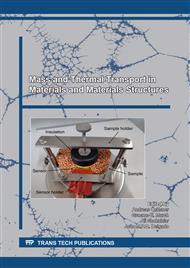[1]
L.J.R. Nunes, T.P. Causer, D. Ciolkosz, Biomass for energy: A review on supply chain management models, Renew. Sustain. Energy Rev. 120 (2020).
DOI: 10.1016/j.rser.2019.109658
Google Scholar
[2]
F. Sher, S.Z. Iqbal, H. Liu, M. Imran, C.E. Snape, Thermal and kinetic analysis of diverse biomass fuels under different reaction environment : A way forward to renewable energy sources, Energy Convers. Manag. (2019).
DOI: 10.1016/j.enconman.2019.112266
Google Scholar
[3]
B. Acharya, I. Sule, A.J.B.C. Dutta, Biorefinery, A review on advances of torrefaction technologies for biomass processing, 2 (2012) 349-369.
DOI: 10.1007/s13399-012-0058-y
Google Scholar
[4]
R.D.B. J.S. Wright, R.J. Hess, S. Sokhansanj,, Review on Biomass Torrefaction Process and Product Properties and Design of Moving Bed Torrefaction System Model Development.
DOI: 10.2172/991885
Google Scholar
[5]
W.-H. Chen, H.-C. Hsu, K.-M. Lu, W.-J. Lee, T.-C. Lin, Thermal pretreatment of wood (Lauan) block by torrefaction and its influence on the properties of the biomass, Energy, 36 (2011) 3012-3021.
DOI: 10.1016/j.energy.2011.02.045
Google Scholar
[6]
M. Phanphanich, S. Mani, Impact of torrefaction on the grindability and fuel characteristics of forest biomass, Bioresource Technology, 102 (2011) 1246-1253.
DOI: 10.1016/j.biortech.2010.08.028
Google Scholar
[7]
T.G. Bridgeman, J.M. Jones, I. Shield, P.T. Williams, Torrefaction of reed canary grass, wheat straw and willow to enhance solid fuel qualities and combustion properties, Fuel, 87 (2008) 844-856.
DOI: 10.1016/j.fuel.2007.05.041
Google Scholar
[8]
Y. Mei, R. Liu, Q. Yang, H. Yang, J. Shao, C. Draper, S. Zhang, H. Chen, Torrefaction of cedarwood in a pilot scale rotary kiln and the influence of industrial flue gas, Bioresour. Technol. 177 (2015) 355–360.
DOI: 10.1016/j.biortech.2014.10.113
Google Scholar
[9]
D. Chen, A. Gao, Z. Ma, D. Fei, Y. Chang, C. Shen, In-depth study of rice husk torrefaction: Characterization of solid, liquid and gaseous products, oxygen migration and energy yield, Bioresour. Technol. 253 (2018).
DOI: 10.1016/j.biortech.2018.01.009
Google Scholar
[10]
S.X. Li, C.Z. Chen, M.F. Li, X. Xiao, Torrefaction of corncob to produce charcoal under nitrogen and carbon dioxide atmospheres, Bioresour. Technol. 249 (2018) 348–353.
DOI: 10.1016/j.biortech.2017.10.026
Google Scholar
[11]
N. Soponpongpipat, D. Sittikul, P. Comsawang, Prediction model of higher heating value of torrefied biomass based on the kinetics of biomass decomposition, J. Energy Inst. 89 (2016) 425–435.
DOI: 10.1016/j.joei.2015.02.011
Google Scholar
[12]
N. Tharawadee, N. Thuchayapong, Effects of Torrefaction Process on Physical Properties and Operating Cost of Biomass Powder, J. Res. Appl. Mech. Eng. 3 (2015).
Google Scholar
[13]
W. Junsatien, N. Soponpongpipat, S. Phetsong, Torrefaction reactors, J. Sci. Technol. MSU. 32 (2013).
Google Scholar
[14]
A.A. Boateng, Rotary kiln transport phenomena and transport processes.
Google Scholar
[15]
A. Gunnarsson, K. Andersson, B.R. Adams, C. Fredriksson, International Journal of Heat and Mass Transfer Full-scale 3D-modelling of the radiative heat transfer in rotary kilns with a present bed material, Int. J. Heat Mass Transf. (2019).
DOI: 10.1016/j.ijheatmasstransfer.2019.118924
Google Scholar
[16]
B. Colin, J.-L. Dirion, P. Arlabosse, S. Salvador, Experimental Study of Wood Chips Torrefaction in a Pilot-Scale Rotary Kiln, in: ICONBM: INTERNATIONAL CONFERENCE ON BIOMASS, PTS 1 AND 2, Vol. 37, Florence, Italy, 2014, pp. pp.505-510.
Google Scholar
[17]
A. CHATTERJEE, A. V Sathe, M.P. Srivastava, P.K. Mukhopadhyay, Flow of Materials in Rotary Kilns Used for Sponge Iron Manufacture: Part I. Effect of Some Operational Variables, 14 (1983).
DOI: 10.1007/bf02654356
Google Scholar
[18]
A. CHATTERJEE, A. V Sathe, P.K. Mukhopadhyay, Flow of Materials in Rotary Kilns Used for Sponge Iron Manufacture: Part II. Effect of Kiln Geometry, 14 (1983) 383–392.
DOI: 10.1007/bf02654357
Google Scholar
[19]
A.S.B. Njeng, S. Vitu, M. Clausse, J. Dirion, M. Debacq, Effect of lifter shape and operating parameters on the fl ow of materials in a pilot rotary kiln : Part I . Experimental RTD and axial dispersion study, Powder Technol. 269 (2015) 554–565.
DOI: 10.1016/j.powtec.2014.03.066
Google Scholar
[20]
A.S.B. Njeng, S. Vitu, M. Clausse, J. Dirion, M. Debacq, Effect of lifter shape and operating parameters on the flowofmaterials in a pilot rotary kiln: Part II. Experimental hold-up and mean residence timemodeling, (2015) 566–576.
DOI: 10.1016/j.powtec.2014.05.070
Google Scholar
[21]
X. Liu, S. Eckehard, Mean residence time and hold-up of solids in rotary kilns, Chem. Eng. Sci. (2006) 5176–5181.
DOI: 10.1016/j.ces.2006.03.054
Google Scholar


